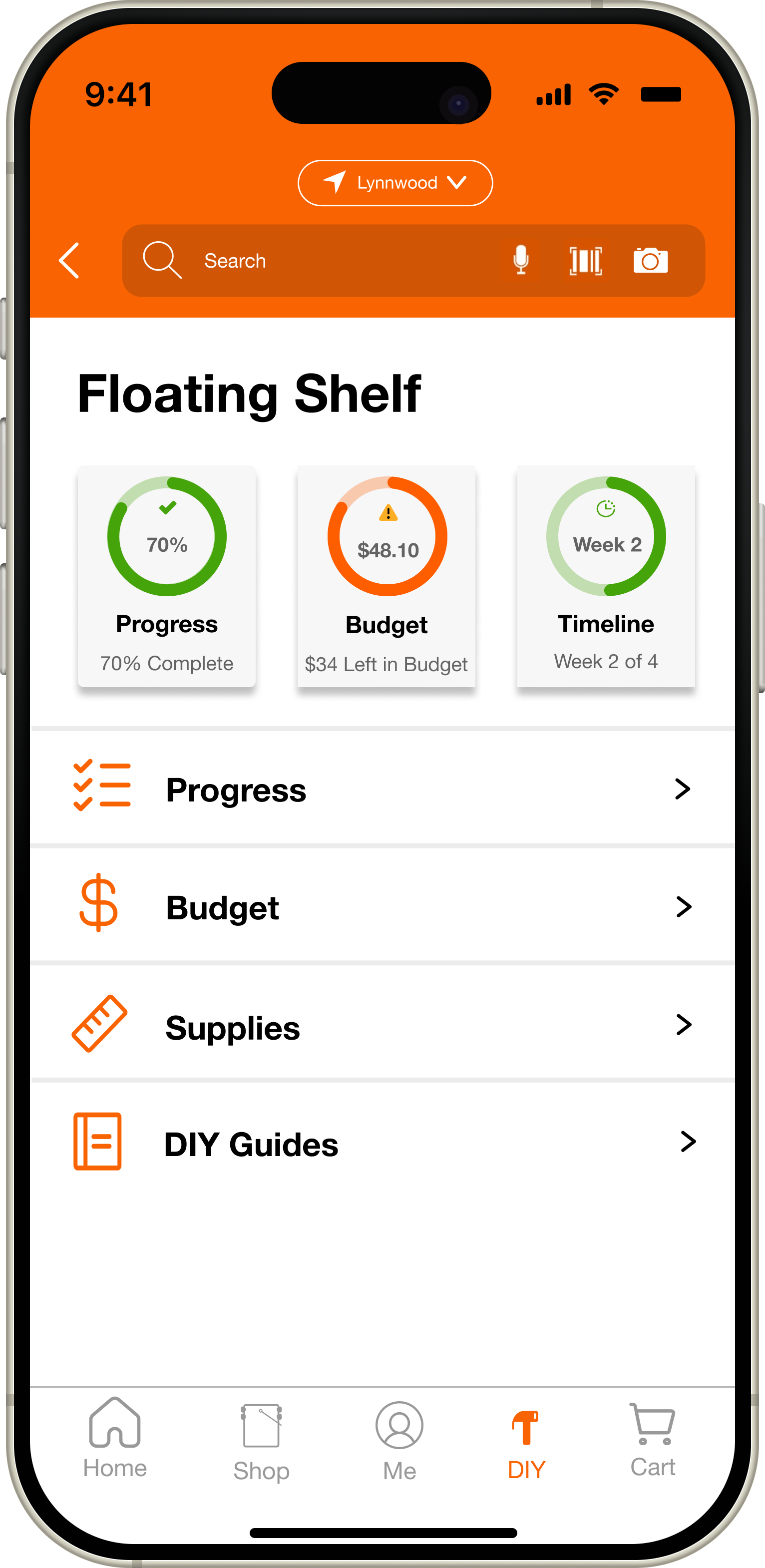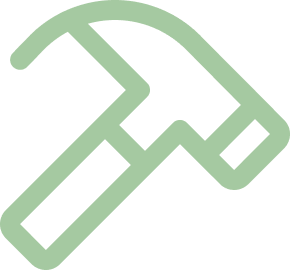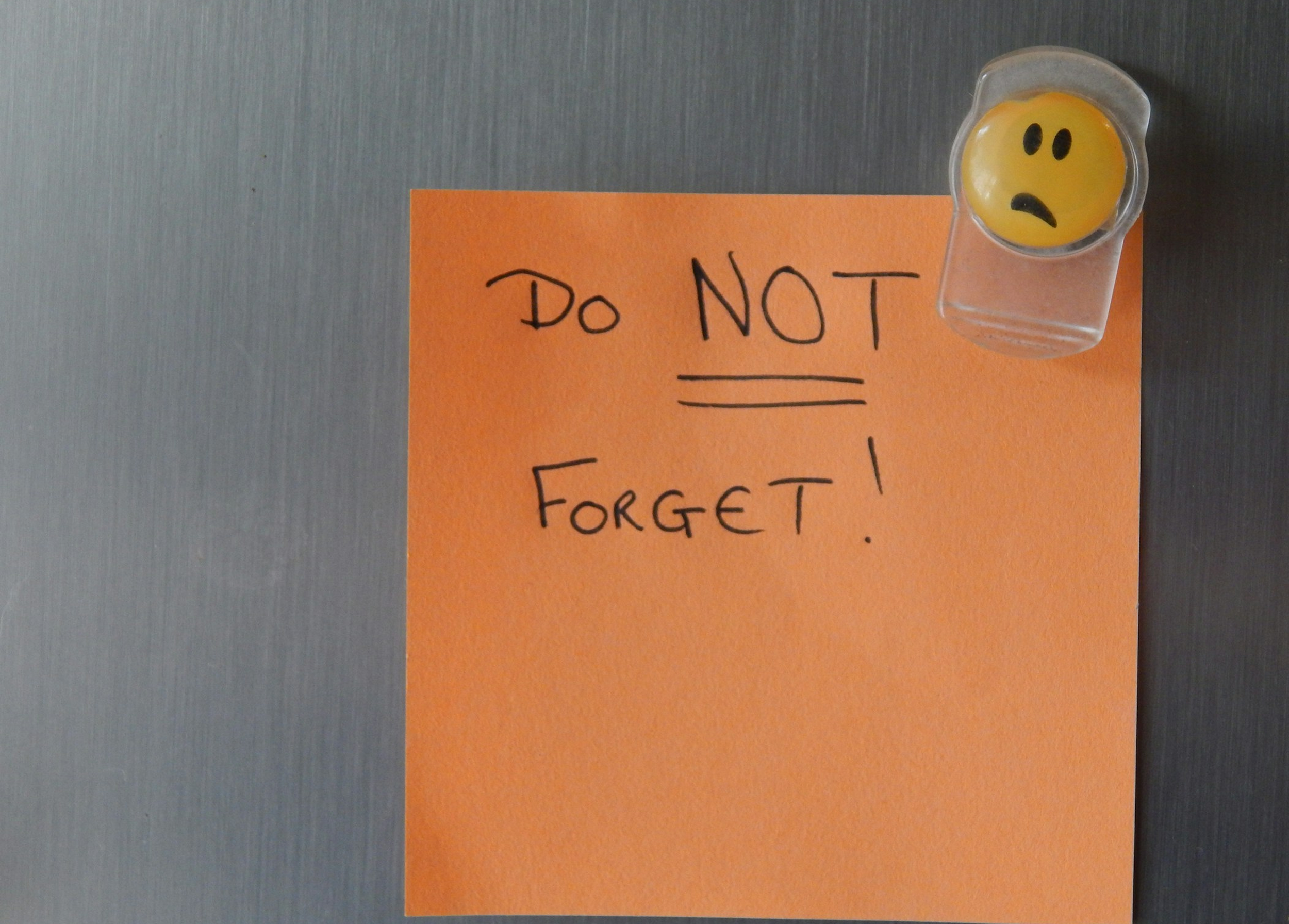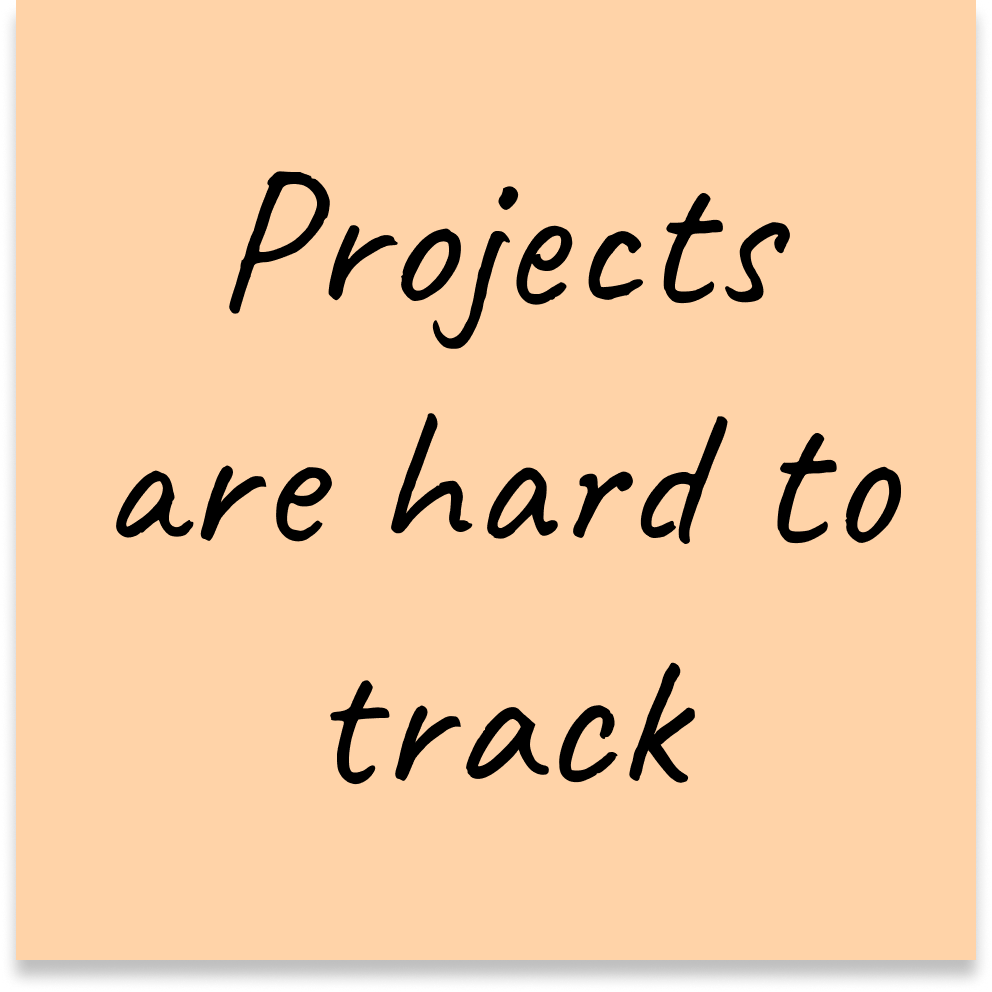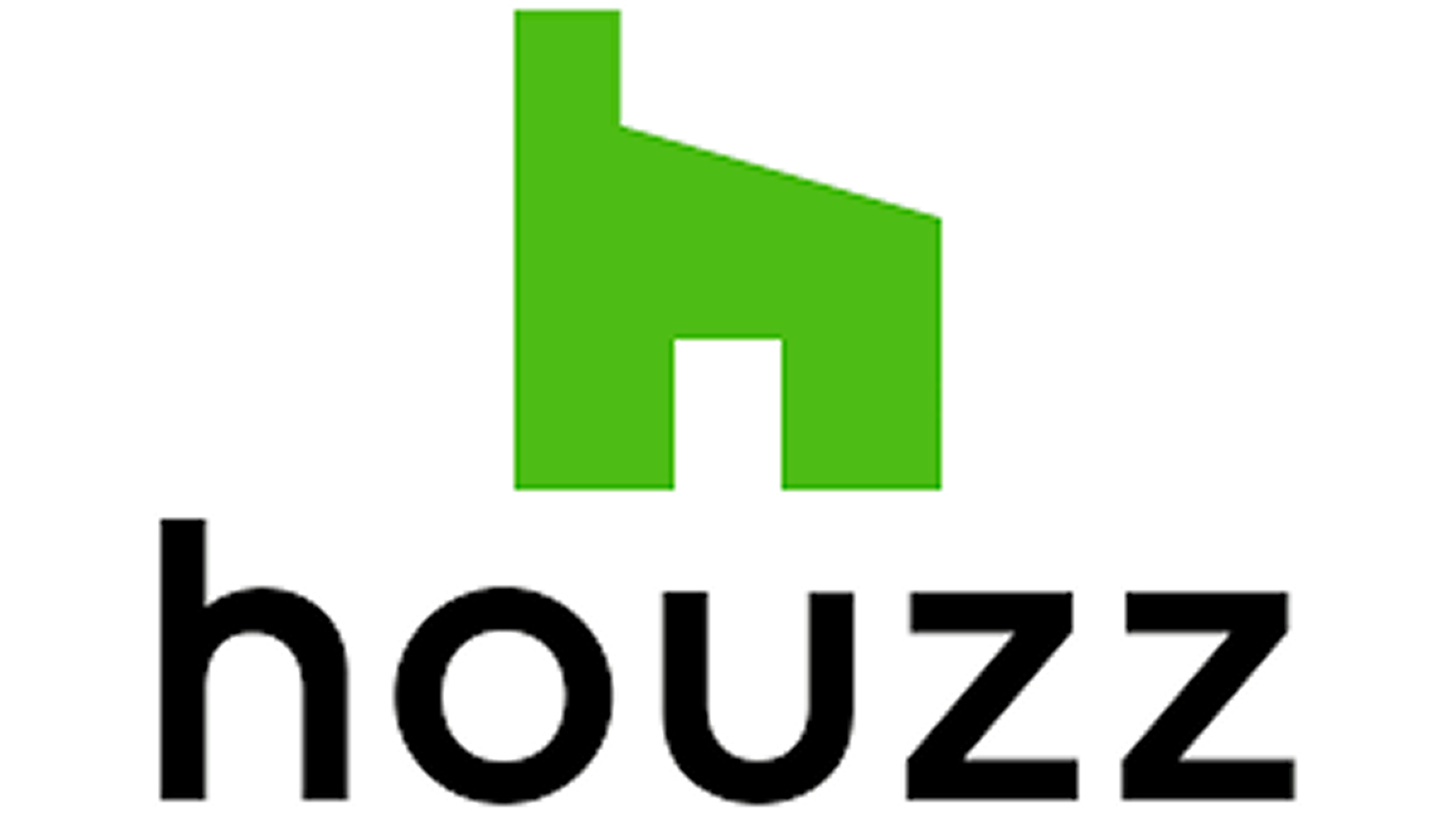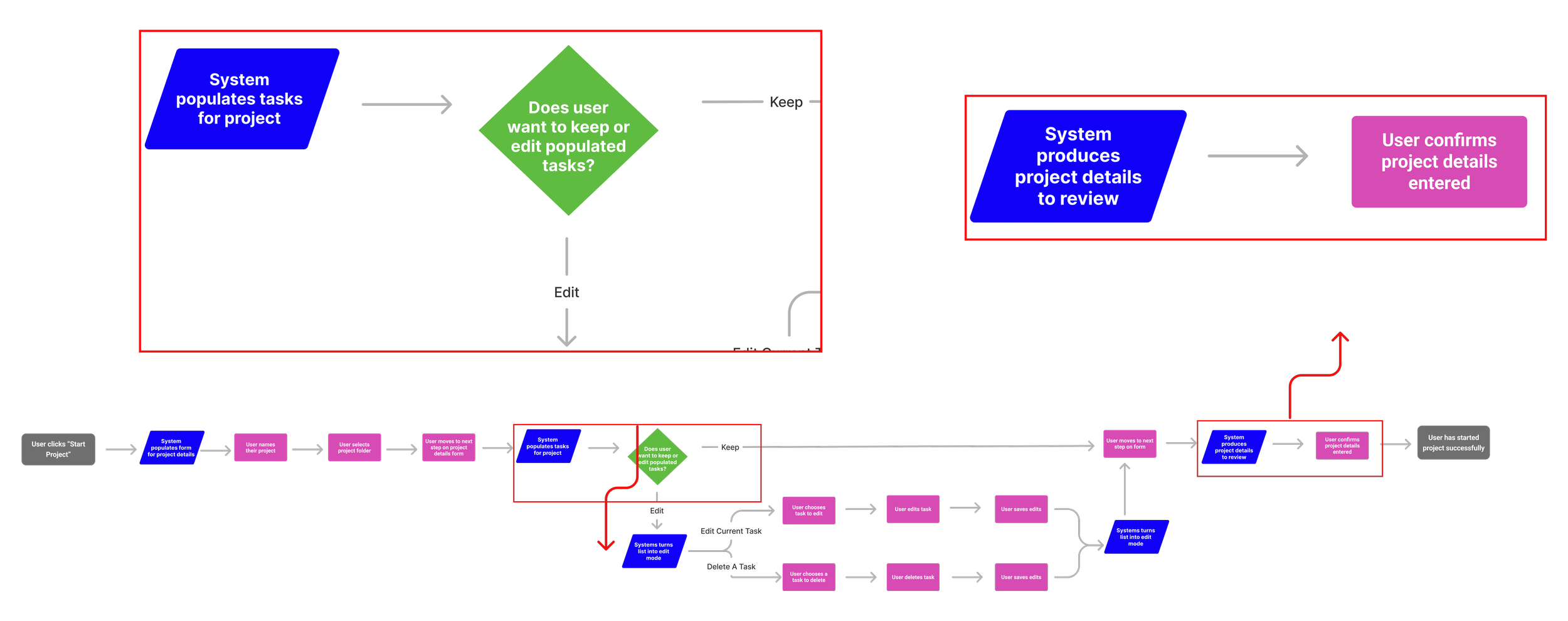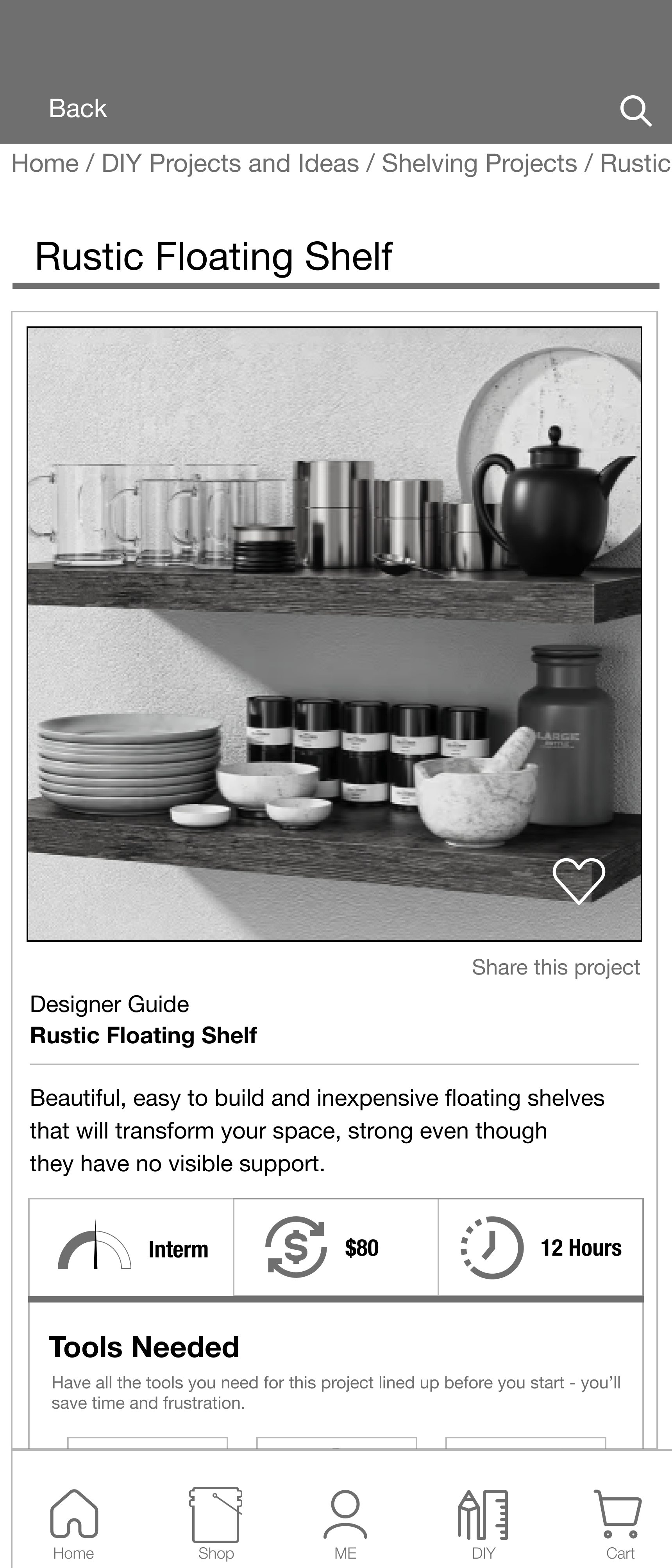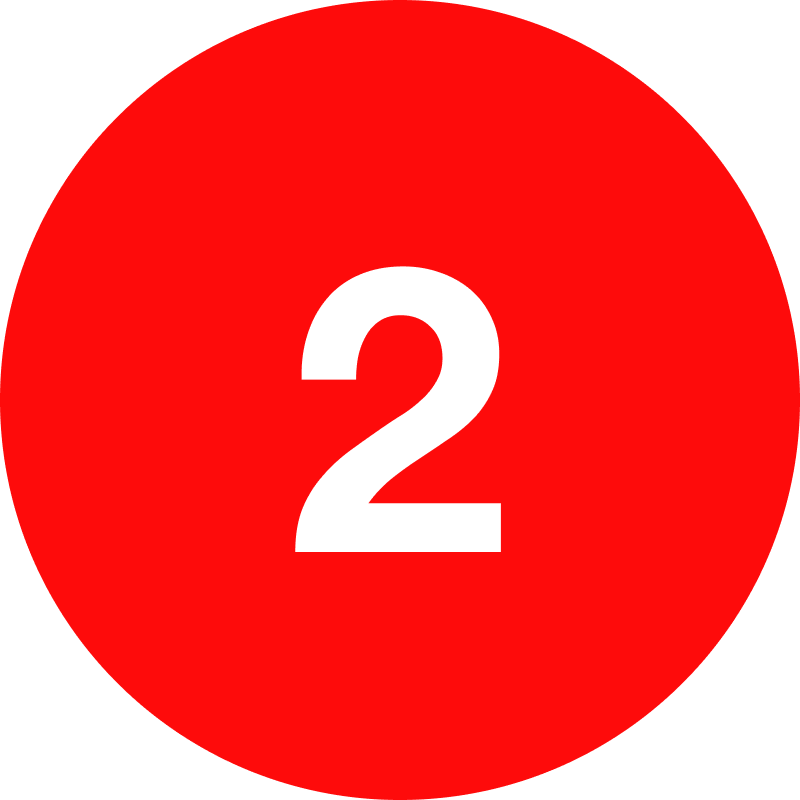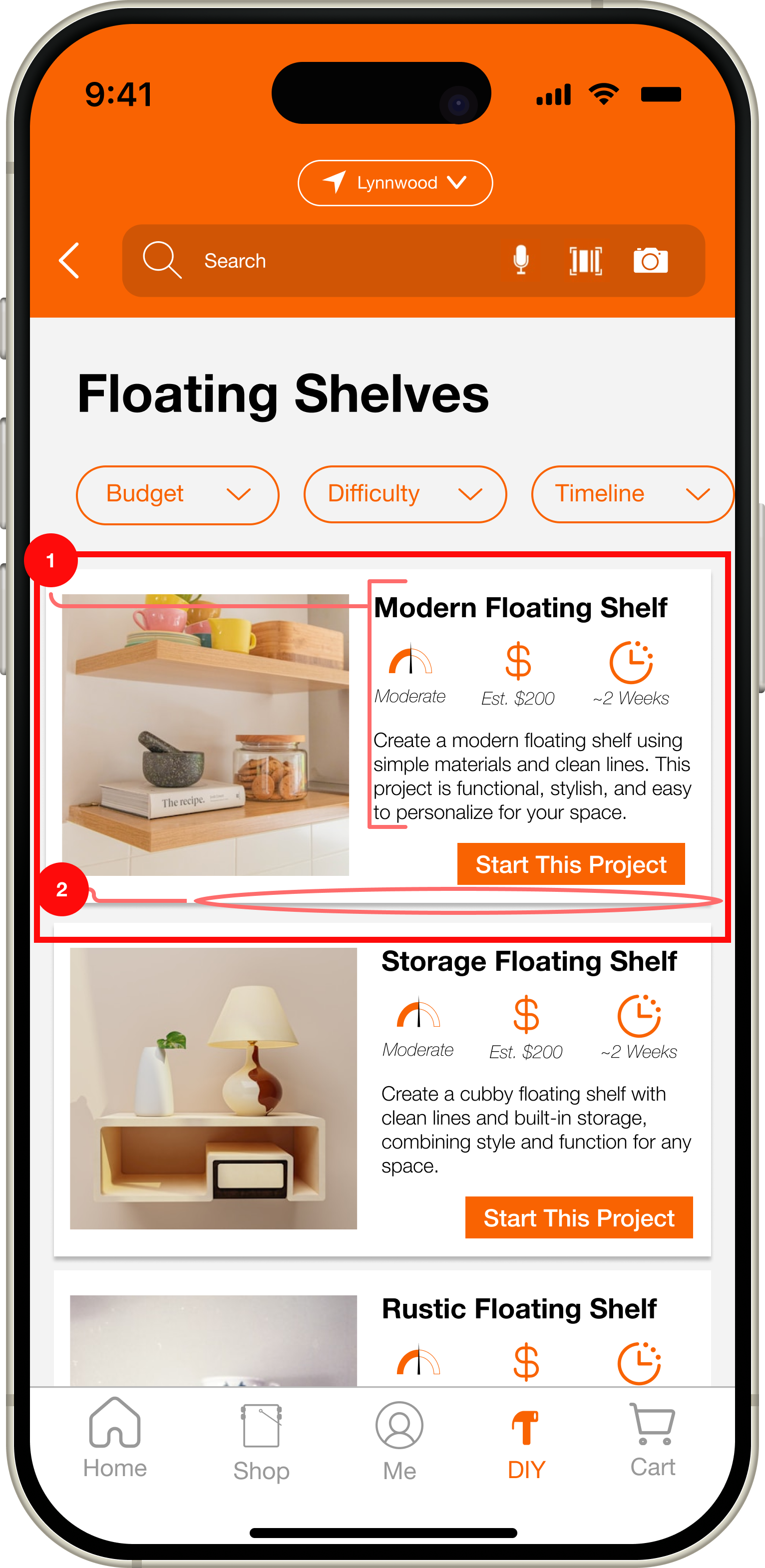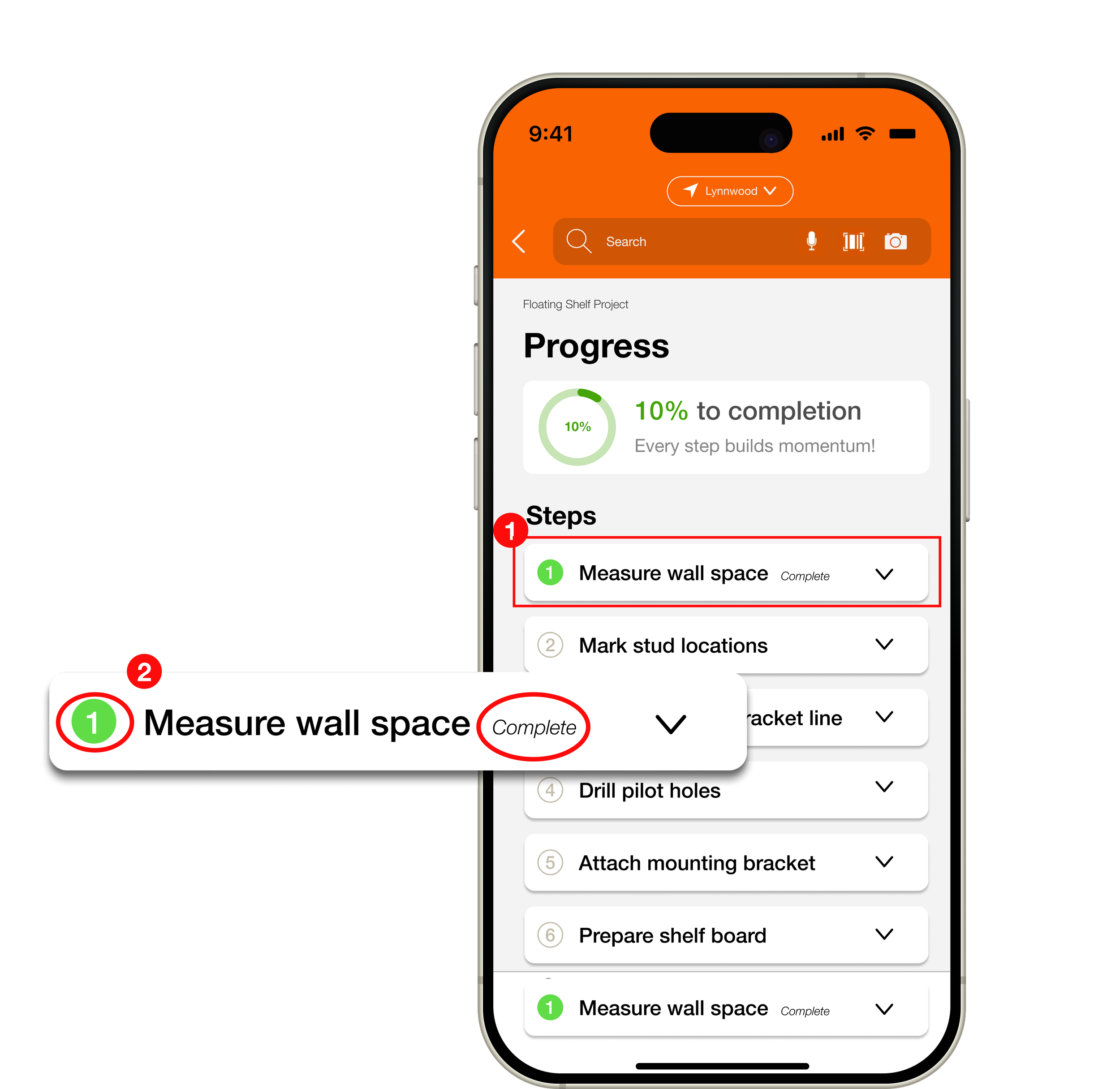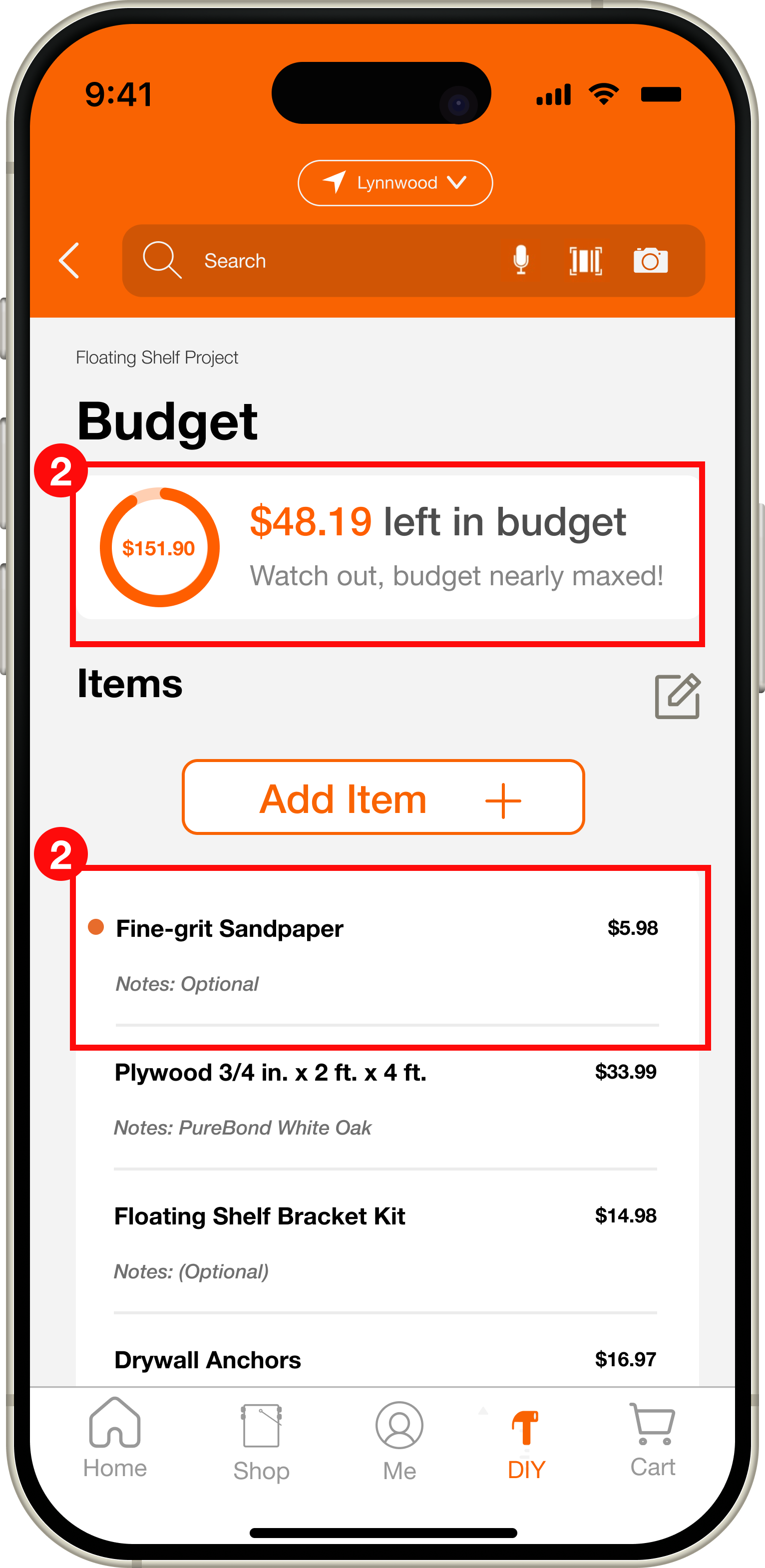Project Summary: I led research and eventually took over mobile design for a school project that focused on keeping DIYers organized and on track to complete projects.
Responsibilities: Qualitative Research, Mobile experience Design, Prototype & usability testing
Timeline & Team: 3 weeks from start to finish with a 3 person (Project Lead, Research Lead, & Design Lead), fully remote team
Key Outcomes: Completed an MVP concept within scheduled deadline
User Research and Product Design for a Home Depot Mobile App That Simplifies DIY Project Tracking and Budgeting
COMPANY OVERVIEWThe Home Depot dominates the home improvement market with products and services for both professionals and DIYers, and the company continues to benefit as DIY projects grow in popularity.
Despite The Home Depot’s strong product and service offerings, research showed DIYers still needed a way to plan and track their projects effectively
DIYers represent almost 50% of Home Depot’s customer base
PROJECT SUMMARYThe goal of our project was to create a concept mobile app that helps DIYers of all levels track progress, manage key details, and access resources in one place.
PROCESS
For 3 weeks, I led the UX Research efforts and participated in the UX Design while working with a Project Manager and Design Lead.
Week 1:
Conducted Interviews, C+C Analysis, and synthesized research
Planned and conducted 15 remote interviews with DIYers, ranging from novice to advanced. found via online surveys.
Conducted a C+C Analysis.
Synthesized all research to start crafting solutions.
Week 2:
Prototyping, feature iteration & prioritization, user testing
Rapidly prototyped potential solutions
Iterated designs to prepare for testing
Created a test plan and ran user sessions
Synthesized and summarized results
Week 3:
Finalizing Hi-Fidelity designs
Translated mid-fidelity wireframes into polished hi-fi mockups
Incorporated feedback from testing into final designs
Week 4:
MVP Project walkthrough
Presented entire research findings and MVP walkthrough
RESEARCHPlanned and conducted 15 remote interviews with DIYers to understand the challenges thatg face at any skill level in every stage of their DIY projects.
10 intermediate to advanced DIYers
SAMPLE QUESTIONS
Why did you put yourself in this category?
What are things you consider before taking on a project?
What are common challenges you run into while completing a DIY project?
3 Novice DIYers
SAMPLE QUESTIONS
What is the most frustrating part about a DIY project?
What projects are you most comfortable taking on considering your skill level?
What resources do you use when you during a DIY project?
2 beginner DIYers
SAMPLE QUESTIONS
What got you into DIY?
What has been the hardest thing about DIY so far?
How would you handle (or have handled) unexpected delays?
RESEARCHDIYers’ patience and creativity fuel their projects, yet without clear tracking, unexpected delays throw timelines off course.
“I don’t really have a way to track my projects. I just wing it and hope it works out. Since I plan everything in my head, I always expect delays.”
“
RESEARCHThe research interviews and analysis revealed that DIYers lacked the tools and organization needed to confidently plan and complete projects
DIYers’ confidence dwindles when unclear starting points, inconsistent guidance, and missed steps create challenges mid-project and lead to delayed timelines.
Projects become difficult to track because there isn’t a centralized tool where DIYers can go to for support.
Timelines are rarely set as most DIYers “plan everything in their head,” making delays, setbacks, and lost time and money an accepted part of the process.
Living situation impacts projects — renters favor quick fixes, while homeowners pursue bigger, long-term improvements.
RESEARCHBased on our research, I defined a primary user for Home Depot’s DIY app — someone who relies on it from inspiration to project completion.
Hannah
Home Owner & Advanced DIYer
Track DIY projects from start to finish to ensure positive results
Create better project timelines to avoid wasting money and critical time
Wants to
Lacks a reliable way to track project details or timelines, leading to overwhelm
Often loses track of project status due to competing responsibilities
Feels wasted time on avoidable tasks contributes to project delays
Key Insights
RESEARCHOur competitor analysis examined how companies serve users across various experience levels
The positive elements learned from competitors:
Creative ways to inspire DIY projects
Helpful buy guides for DIYers
Where competitors fall short:
Creative ways to inspire DIY projects
Lowe’s UI was overwhelming and hard to navigate
Ikea only supports small-scale projects
RESEARCHOur comparator analysis examined how companies inspire users and simplify information based on skill level
Elements from comparators that would influence the Home Depot DIY App:
Displayed a wide variety of products without overwhelming users
Provided effective support for users across skill levels
Offered inspiration to spark project ideas
PRODUCT STRATEGYAlthough competitors struggled to meet DIYers’ needs, comparators offered inspiration and clarity that we translated into a solution-focused on tracking budgets, timelines, and successful project completion
EXPERIENCE DESIGN With no existing flows to build from, I used our “How Might We” ideas to shape that prospective user flows that prioritized organization, clear progress tracking, and timely project completion
DIYers can begin projects with confidence — drawing inspiration from the app.
Finding Inspiration
Users can track budgets and, eventually, upload receipts, with changes updating in real time.
Budget Tracking
Project tracking with the user being able to check off tasks, making it easier for users to pick up where they left off.
Task Tracking
EXPERIENCE DESIGN I mapped the experience of DIYers starting their projects, showing how populated task check-offs encourage easy project initiation
I mapped the experience of DIYers starting their projects, revealing how important it is to make the first step effortless
EXPERIENCE DESIGN Next, I outlined the experience of DIYers keeping track of their project budget, showing how updating project expenses can encourage consistent engagement
I designed expense tracking to be quick and simple by adding just two fields (item and cost), so users can update their budget without extra effort.
EXPERIENCE DESIGN Finally, I outlined the experience of DIYers checking off project tasks, showing how quick confirmations keep them organized and confident in continuing or resuming their projects
I designed task check-offs to be quick and consistent to reduce friction and encourage users to return to their projects regularly.
PROTOTYPE, TEST & ITERATE Refined early concepts into a mid-fidelity prototype in Figma for a moderated usability testing
Why moderated testing?
Chose moderated testing to observe real-time reactions and gather immediate feedback
Asked follow-up questions during sessions to clarify user intent
Aimed to gain deeper insight into user behavior and usability patterns and evaluate task completion
Tested with users of varying tech savviness to uncover a broader range of usability issues
PROTOTYPE, TEST & ITERATE Usability testing revealed that unclear CTAs, clunky UI, and weak signifiers caused hesitation and confusion when navigating the app
Oh that was clickable? If I had known that, I probably would have completed [the task] faster
-User Testing Participant
“
PROTOTYPE, TEST & ITERATE Although the project concluded before high-fidelity designs, I extended the work independently and redid all mobile design to refine the solution and push for better outcomes.
PROTOTYPE, TEST & ITERATE Improved visual hierarchy and incorporating clear signifiers helped users scan content quickly and focus on what mattered
I simplified the layout and reduced clutter, creating a clear hierarchy that highlights primary actions while still preserving the key information users need when searching for inspiration for a DIY project
I applied drop shadows to content cards as visual signifiers, helping users recognize clickability and reducing hesitation.
PROTOTYPE, TEST & ITERATE While users liked the ability to check off tasks, they felt the action lacked the satisfying sense of progress that comes with completing a list
I introduced a progress bar so users could track progress in real time, turning task completion into a motivating experience that helps them stay on schedule
I introduced a progress bar so users could track progress in real time, turning task completion into a motivating experience that helps them stay on schedule
PROTOTYPE, TEST & ITERATE Streamlining the process of adding items encouraged users to actively maintain and monitor their budgets
With just two steps, adding a budget item felt quick and effortless for users.
Because past items stayed visible and budgets updated in real time, users found it simple to monitor progress and avoid surprises.
OUTCOMES & LESSONSSupporting specific users requires designing beyond the screen, considering both mobile interactions and the real-world contexts that shape their experience
Key Outcomes and Results
Quick and easy became the name of the game: In the second round of testing, users said the app was simple to use, even when their hands were occupied.
An app for everyone: In contrast to competitors, the Home Depot app resonated with DIYers across every experience level.
What I Learned
Keep MVP projects MVP: I learned how easy it is to get pulled into designing extra features, but research helped me refocus on what mattered most for users.
Design with business success in mind: This project taught me to balance user needs with business goals, like highlighting tools in project flows to encourage purchases directly from Home Depot and support revenue growth.


